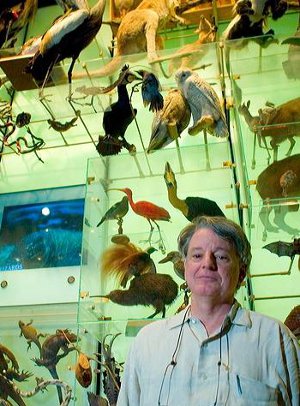
Joel Cracraft
(American Museum of Natural History, USA)

ABSTRACT
Reconstructing the history of ecological assemblages at different spatiotemporal scales: an evolutionary approach.
Joel Cracraft1,2 Brian Weeks2 , Santiago Claramunt1, 1. Department of Ornithology, American Museum of Natural History, New York, New York USA, 2. Department of Ecology, Evolution and Environmental Biology, Columbia University, New York, New York USA
Understanding how and why a given ecological assemblage has the taxonomic composition it does has become a topic of intense interest to ecologists as well as evolutionary biologists. Most of the recent approaches to this topic reflect an ecological perspective in which either the dynamics of biotic interactions, or the filtering action of ecological conditions of the region, are seen as the primary causal mechanisms structuring the taxonomic composition of the ecological units in question. At the same time, phylogenies, typically from concatenated supertrees, are sampled in order to test whether the taxa that are present in the assemblage represent a random sample across the tree or are "overdispersed" or "underdispersed" phylogenetically.
We will propose an alternative approach to looking at species assembly, one that recognizes that clades of organisms, at all taxonomic scales, are nonrandomly distributed with respect to their history. This implies that species assemblages should be expected to be significantly constrained historically and that patterns of assembly should show hierarchically, phylogenetic structure. By understanding this history, one can better tease apart the influences of "nonhistorical" local, or temporally-short factors, such as biotic interactions. Some of these approaches will be illustrated by considering the evolution of the South American avifauna.
(American Museum of Natural History, USA)

ABSTRACT
Reconstructing the history of ecological assemblages at different spatiotemporal scales: an evolutionary approach.
Joel Cracraft1,2 Brian Weeks2 , Santiago Claramunt1, 1. Department of Ornithology, American Museum of Natural History, New York, New York USA, 2. Department of Ecology, Evolution and Environmental Biology, Columbia University, New York, New York USA
Understanding how and why a given ecological assemblage has the taxonomic composition it does has become a topic of intense interest to ecologists as well as evolutionary biologists. Most of the recent approaches to this topic reflect an ecological perspective in which either the dynamics of biotic interactions, or the filtering action of ecological conditions of the region, are seen as the primary causal mechanisms structuring the taxonomic composition of the ecological units in question. At the same time, phylogenies, typically from concatenated supertrees, are sampled in order to test whether the taxa that are present in the assemblage represent a random sample across the tree or are "overdispersed" or "underdispersed" phylogenetically.
We will propose an alternative approach to looking at species assembly, one that recognizes that clades of organisms, at all taxonomic scales, are nonrandomly distributed with respect to their history. This implies that species assemblages should be expected to be significantly constrained historically and that patterns of assembly should show hierarchically, phylogenetic structure. By understanding this history, one can better tease apart the influences of "nonhistorical" local, or temporally-short factors, such as biotic interactions. Some of these approaches will be illustrated by considering the evolution of the South American avifauna.
